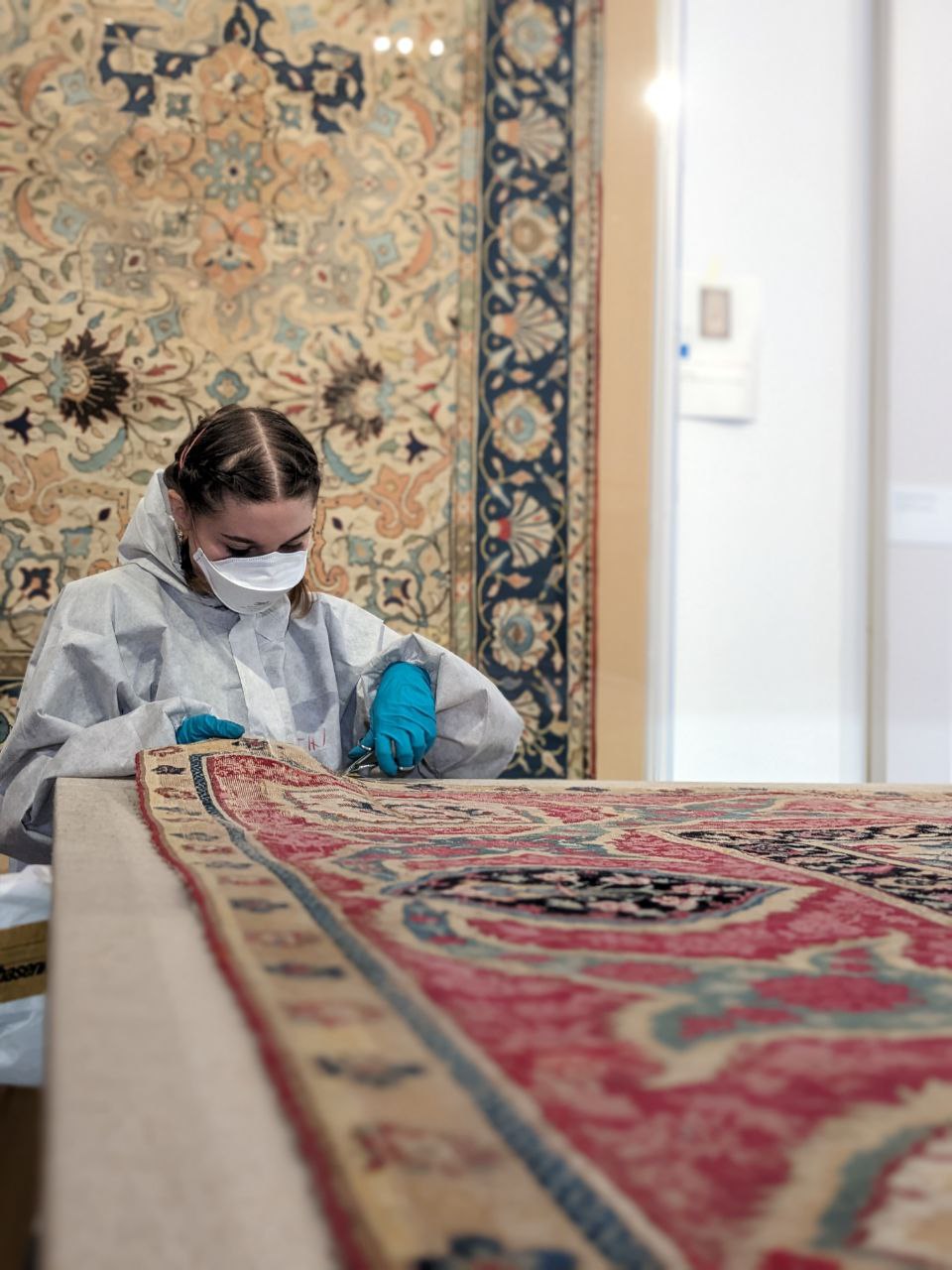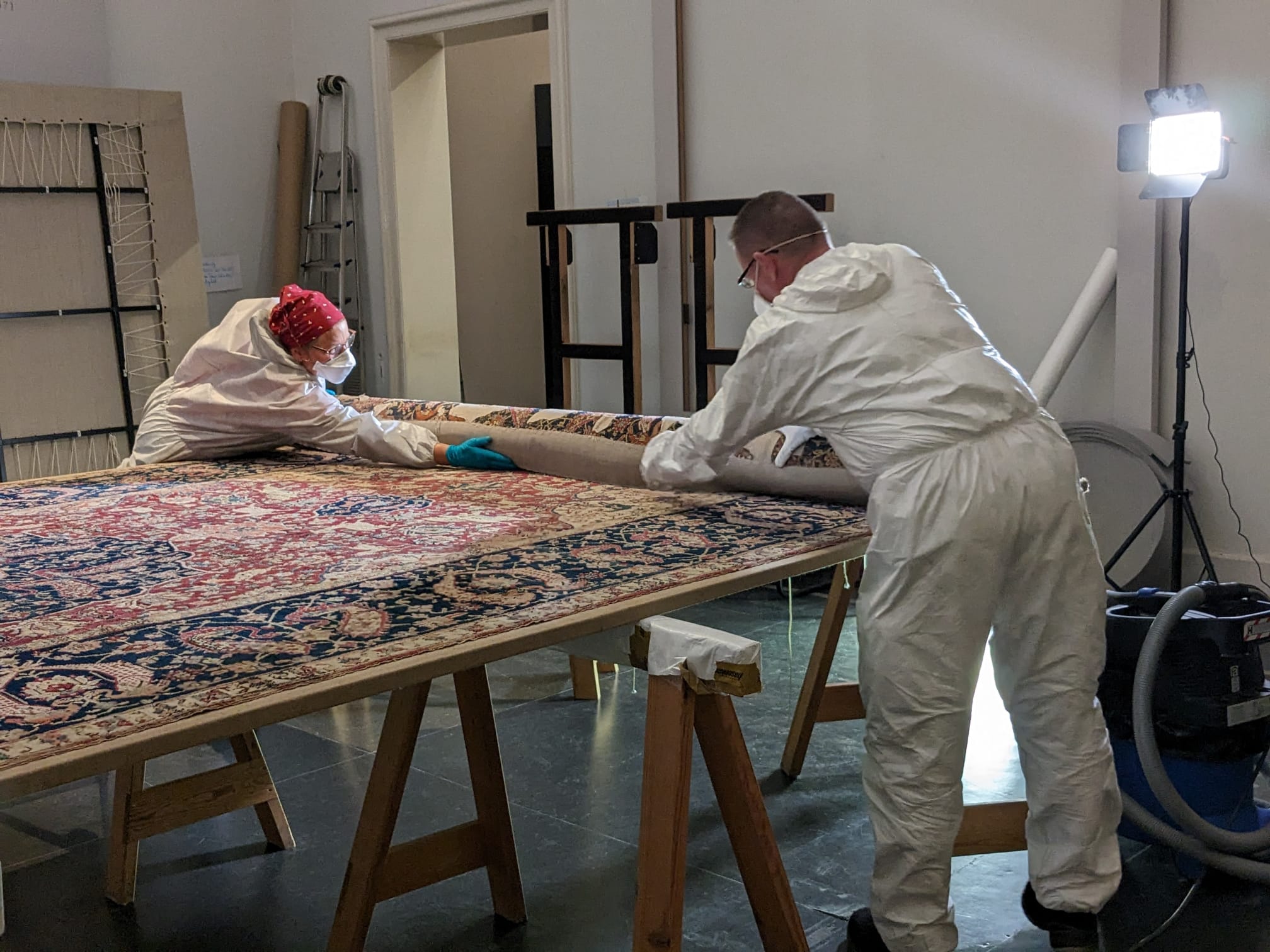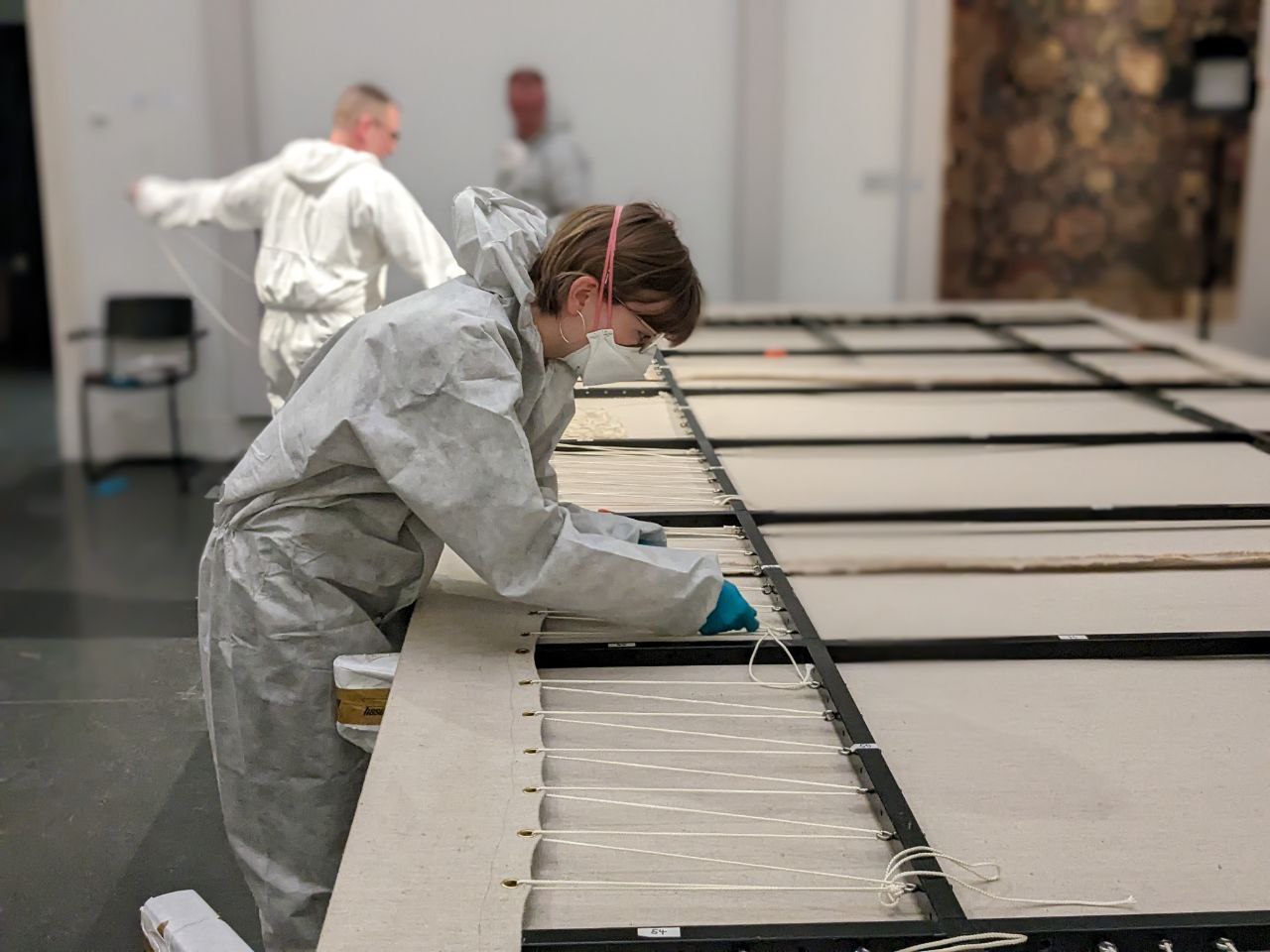en
- de
- en
What goes on in the museum when it is closed?
The Pergamonmuseum has been closed since the 23rd of October 2023. But even though there are no visitors, the museum is neither quiet nor desolate. On the contrary, the preparations for the renovation of the museum are already in work. This means that the rooms are being cleared from the glass cabinets, benches, informative texts and of course, the exhibits. One of the first exhibits to be moved were the carpets.
Carpets have played a vital role to the collection ever since its founding in 1904. After all, the founding was made possible, among other things, by the donation of Bode’s private carpet collection. Even the museum's first inventory number I. 1 was given to a carpet.
In this story, we show you how the dismantling of the carpets from the permanent exhibition took place.
Preparation for dismantling
Before the disassembly can begin, intensive safety measures are implemented in the museum. Only a limited group of people have access to the museum at all, and within this group, meticulous records are kept of who checks in and out and when. This ensures that the objects are protected from theft and damage, and that the staff are not unnecessarily hindered by too much foot traffic during the dismantling process.
In addition to the safety of the exhibits, the safety of the staff is also priotitized. This can be especially seen in the treatment of dust. The exhibition stood for 23 years and many carpets were treated with biocide – substances for mitigating damage through vermin. However, too much contact and inhalation of the contaminated dust can lead to health complications. Therefore, the carpet rooms are isolated with dust protection doors and the staff is required to wear gloves, masks and full-body protection suits. In preparation, the rooms are cleared from exhibits of other material, which includes benches and display cases and informational panels. This ensures, that there is enough space to work and that no other exhibits are damaged during the process, following which all necessary material is laid out and the work can begin.
Click on the black dots to learn more about our materials
Dismantling process and experiences
Vacuum Cleaning
At the very beginning, the carpets need to be carefully vacuum cleaned. In order to protect the fragile fibers, we use very gentle bristles and lay a finely woven dusting net over the carpet. Depending on the size of the carpet (and the largest is about seven metres in length), the task is not as easy as it seems. You need a lot of stamina to balance yourself on the ladder or scaffold while coordinating both hands above the head to reach every last fibre.
But despite the tiring effort, it is not an unrewarding task. You get the chance to get as close to the carpet as possible. This does not only allow for getting a very close look of the intricate patterns and motifs, but also the (careful) touch adds a sensory experience in understanding the carpet.
The carpet becomes even more real and the experience deepens the appreciation for the artistry behind it that surpasses a simple stroll through the exhibition.
Unhitching
After that, the frame on which the carpet is mounted is unhitched from the wall. Depending on the size of the carpet, you might need more or fewer hands to keep its frame steady while the clasps are loosened. If possible, it is immediately weighed, to record the weight of frame, carpet and tarp. Once the frame issecurely placed on foam upholstery, the back of the carpet is also vacuumed. This is less complicated, as the tarp upon which the carpet is fixed, doesn't need special protection. A sketch of the frame and its measurements are taken during this step as well.
Cutting threads
Now the next step involves placing the carpet frame on supports so that the seams can be comfortably opened, fixing the carpet from behind and on the sides on the tarp. The front side of the carpet is laid upon the trestles, face up. The threads, that hold the carpet to the tarp from the sides and from below are cut off and taken out. Especially when sitting under the carpet, you appreciate that the carpet was vacuumed beforehand otherwise, you might have dust particles flaking down on you.
Rolling up
Finally, the carpet is rolled up for storage around an acid-free roll. An initial rolling and unrolling helps with careful turning of the carpet, so that the back side faces upwards. During the second rolling process, a protective fabric is included which fully wraps around the rolled-up carpet. The final product is weighed and packed in custom-fitted crates. In order to protect the fibers, a carpet is always rolled up from top to bottom, depending on how it was knotted. Similar to rolling up an animal hide, the aim is to roll the wool fibers smoothly, and not "against the grain."
Loosening
But even though the carpet itself is safely stored, the work isn't over yet - quite the contrary. In the next step the tarp is separated from the frame. The ropes holding the tarp with quite an amount of tension are loosened, wound up and their frayed ends welded together with just a bit of fire power. Some tarps are packed up to be used again after being weighed; others must be thrown away because of their biocide contamination.
Breaking apart
The frame is weighed again and its singular square tubes numbered, so that it can be assembled again for the next exhibition. Following which, it is dismantled into its individual parts with a hammer which allows for releasing all the tension that has been mounting up while carefully handling the carpet in the previous steps. Then the work is complete. All data is gathered and identification papers are pinned together with a satisfactory feeling on to the wall displaying the finished work. Smaller carpets do not go through this process but are packed still attached to tarp and frame.
A museum - only a building?
One seldom thinks about the work that goes into the (dis-)assembling of an exhibition. Seeing that it is neither witchcraft nor rocket science is almost disappointing, because it demystifies the exhibits. At the same time, it is an opportunity to learn a great deal about their special features and nature. It is also a strange feeling to contribute to emptying a museum. After all, a museum without exhibits is simply a building like any other. However, this dismantling process does not mark an end, but rather a beginning.
What happens now?
Restoration and storage of the carpets
For a brief period, the carpets will spend a short time in a nitrogen chamber so that potential vermin are killed off. Until the reopening of the permanent exhibition, they are then either stored in deposits or undergo restoration. If you are interested in the restoration of carpets, watch the video to get more information. And thus, the carpets are already being prepared for another presentation in the not-so-distant year of 2027.
Where is the Dragon?
The star of the "CulturalxCollabs - Weaving the Future" project is a so-called Caucasian dragon carpet from the 17th century. A dragon carpet - all well and good - but: where is the dragon?




